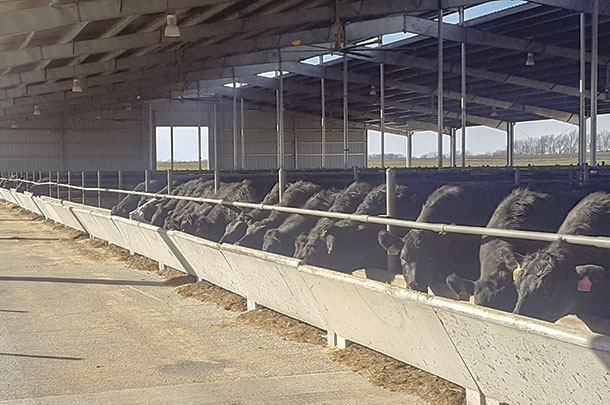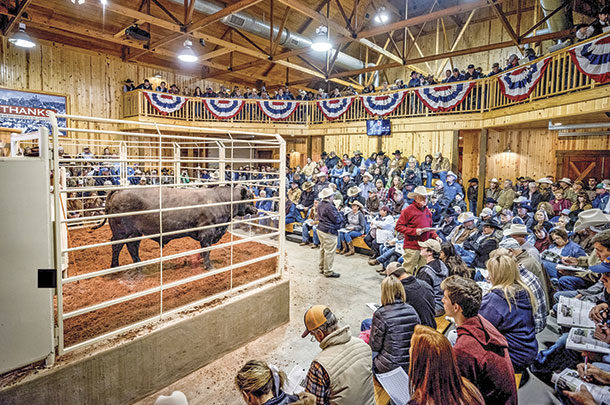Seedstock buyback programs are popular for customers and breeders alike. Commercial producers receive higher prices for high-quality cattle, with a ready market for superior calves. Learn more about the do’s and don’ts when incorporating a buyback program into your seedstock operation.
Family-owned-and-operated Schiefelbein Angus, near Kimball, Minnesota, has offered a buyback program for 26 years. Tim Schiefelbein says, “We were producing animals with high-quality genetics. We felt ranchers should be rewarded for buying genetics that produced calves with carcass quality and good feed conversion characteristics.”
Schiefelbein learned the art and science of purchasing cattle as head cattle buyer for several large packers, including JBS and Monfort. Applying proven risk management strategies, this outfit either buys customers’ calves or markets them for other buyers. The producer receives more money for his animals and additional genetic data for future herd improvements. Commercial operators value timely, expert advice from proficient seedstock producers.
The right feedyard is crucial for successful buyback programs. “It boils down to honesty and integrity,” Schiefelbein observes. “Know which feedyards do the best job of feeding calves, finding quality rations and formulations for them.”
The Schiefelbein buyback program is flexible. They accept cattle in the Non-Hormone Treated Cattle (NHTC) Program, All-Natural and regular value-added programs.
“Our breeding program takes a balanced approach,” Schiefelbein explains. “Produce good females first but also excellent feeding and carcass traits, as well as foot and disposition scores. You can get these by using available genetic tools. The genetic EPDs have to be excellent in all areas. If you solely select carcass and feeding traits and forget about the cow herd, your customers will be sorely disappointed.”
According to Schiefelbein, developing the buyback program has been extremely difficult, and few seedstock operators do it right. It takes an amazing amount of capital, connections and work. It is challenging to operate the seedstock side and the buyback program simultaneously, especially when starting. Expect to spend more time and money for the buyback program than on the breeding side.
“Go with a buyback program that fits your operation,” Schiefelbein concludes. “Good buyback programs help commercial guys make more money. Find one that operates honestly, with integrity, and has longevity, so you know it’ll be here this year and into the future.”
Doug Slattery, chief operating officer, established the 44 Farms buyback program to study genetic data and get feedlot and carcass information. Located near Cameron, Texas, 44 Farms collaborated with Walmart four years ago, developing the Prime Pursuits Program. This plan provides beef cuts to 500 Walmart stores in the Southeastern states.
Buyback programs have tremendous benefits for seedstock producers. “We cement our relationship with our bull buyers by supplying data on their cattle, also getting feedlot and carcass results,” Slattery shares. “This information helps us make better breeding decisions, which helps everybody.”
Slattery uses feedlots familiar with feeding program cattle, including NHTC and natural cattle. He expects managers to understand the high-quality beef supply chain. This buyback plan requires weaned calves sired by registered Angus bulls. They must be black or black baldy, raised without hormones.
“Predictability is key to profitability, from the producer to the backgrounder, feedlot, then grocery store,” Slattery reveals. “The more predictable, higher-quality product you have, the more premium is available every step of the supply chain. Once we collect several years of carcass data on a producer, we are comfortable with the resulting product, and we find our breeding program meets their needs.”
The buyback program has helped 44 Farms advance in the seedstock arena, strengthening relationships with bull buyers. Slattery and his team can discuss closeouts with customers and what works or does not work in their operations. They also give customers production advice to help them improve profitability.
“When dealing with a seedstock producer, be sure their genetics fit your needs,” Slattery advises operators. “Be sure it’s someone you can have a long-term relationship with, who is willing to share all data with you.”
Slattery reminds producers that beef consumers will demand a higher-quality product they know more about. “They want to hear the story behind the product, where it came from and how it was handled. Was the animal humanely managed? Is it healthy? That trickles down through the supply chain to the cow-calf producer. If each segment wants to gain profitability or remain profitable, they must produce what this emerging new buyer demands. It is difficult for producers to look down the supply chain to the consumer and realize that’s the person we have to please to get a premium for our product.”
Valley Oaks Farms in Oak Grove, Missouri, established a buyback program four years ago. Jeff Gooden, manager of cattle operations, says they built a modern under-roof feedyard, moving their animals into the facility, promoting their bull genetics. The buyback program encourages higher prices for bulls, and their customers receive a premium for quality calves.
“Calves can have a little extra condition when I buy them from our customers,” Gooden observes. “We want them to be weaned 30 to 45 days and started on feed. The extra condition promotes health; we have a lot less sickness. Those calves are healthier, and they take the stress of moving better than greener, thinner calves.”
Gooden reports the Valley Oaks Farms buyback program helps him know how the genetics are performing, especially since the company is taking a risk to feed customers’ calves. Feeding them under the roof reduces stress. Gooden thinks this moves them to a higher quality grade, although genetics are still critical. Sometimes calves develop a better quality grade without top genetics.
How do customers qualify for the Valley Oaks Farms buyback program? They must have calves sired by a Valley Oaks Farms bull, two rounds of shots, weaned 30 to 45 days and weigh at least 600 pounds. They must be 11 months old or younger.

Valley Oaks Farms’ under-roof feedlot can hold about 600 steers. Photo courtesy of Valley Oaks Farms.
“Everyone wants to make money and save money,” Gooden concludes. “With our buyback program, you’re not paying 60-dollar yardage, commission and shrink at a sale barn on a 600-pound calf. We weigh calves upon arrival; that’s the only shrink they have. We pay the five-cent bonus on top of the average market price from the previous week from that weight class. That’s 30 dollars extra on a 600-pound calf. That makes an expensive bull pay for himself pretty quick.”
To learn more, visit seedstock producers with successful buyback programs. Be willing to ask for advice from land-grant university experts who regularly advise producers.
Mistakes to avoid
Representatives of Schiefelbein Angus, 44 Farms and Valley Oaks Farms give the following advice for rookie buyback programs:
- The lack of flexibility for customers is a mistake beginner buyback programs make, according to Tim Schiefelbein of Schiefelbein Angus. He encourages cattle buyers to become marketing experts.
- The right seedstock producer can help ranchers see the big picture. Doug Slattery of 44 Farms says beginning buyback programs should not overpromise or offer false hope to customers. “Grow into a buyback program. Don’t jump in head-first before you’re ready.”
- Jeff Gooden of Valley Oaks Farms believes new buyback program managers should make sure the genetics they sell are the genetics they want to buy back and feed.








